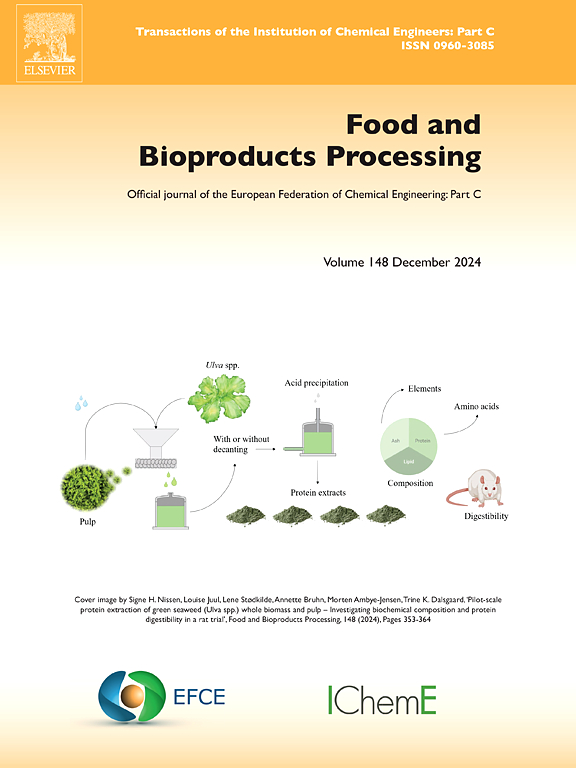可持续葡萄籽油加工:绿色溶剂萃取和副产品增值
IF 3.5
2区 农林科学
Q2 BIOTECHNOLOGY & APPLIED MICROBIOLOGY
引用次数: 0
摘要
以2-甲基氧氧烷(2-MeOx)为绿色溶剂提取食品和化妆品用葡萄籽油(GSO)。分析了油的提取率、生育酚和生育三烯酚含量、脂肪酸和多酚谱,并与正己烷进行了比较。整个提取过程,包括石油化学精炼,在中试规模(15升萃取器)上进行了进一步研究。炼油对微量元素含量有负面影响。甾醇、工具和多酚含量分别降低19.78 %、47.6 %和99 %。在精炼副产物中回收了大量的多酚,在树胶中发现了大约80 %,在肥皂原液中发现了10 %。原油和树胶中含有的多酚对HaCaT角质形成细胞和BJ成纤维细胞有有效的细胞内ROS抑制作用,对B16-F10小鼠黑色素瘤细胞有抗黑素生成作用。因此,这些产品被建议作为治疗色素沉着症的有价值的化妆品成分。综上所述,2-MeOx是一种极好的替代己烷提取GSO的方法,具有提取效率高、毒理学特征更安全、生产的油脂和副产品具有广阔的食品和化妆品应用前景。本文章由计算机程序翻译,如有差异,请以英文原文为准。
Sustainable grape seed oil processing: Green solvent extraction and byproduct valorisation
The extraction of grape seed oil (GSO) for food and cosmetic applications was performed with 2-methyloxolane (2-MeOx) as a green solvent. The oil extraction yield, the tocopherol and tocotrienol content, the fatty acid and polyphenol profiles of the oils were analysed and compared with hexane. The entire extraction process, including the oil chemical refining, was further investigated on a pilot scale (15-litre extractor). Oil refining had a negative effect on the micronutrient content. The content of sterols, tocols and polyphenols was reduced by 19.78 %, 47.6 % and 99 % respectively. High amounts of polyphenols were recovered in refining by-products, with approximately 80 % found in gums and 10 % in soap-stock. The polyphenols contained in the crude oil and gums demonstrated effective intracellular ROS inhibition in HaCaT keratinocytes and BJ fibroblasts, as well as an anti-melanogenic effect on B16-F10 murine melanoma cells. Consequently, these products are proposed as valuable cosmetic ingredients for treating hyperpigmentation disorders. In conclusion, 2-MeOx is an excellent alternative to hexane for GSO extraction, offering high extraction efficiency, a safer toxicological profile, and the production of oil and byproducts with promising food and cosmetic applications.
求助全文
通过发布文献求助,成功后即可免费获取论文全文。
去求助
来源期刊

Food and Bioproducts Processing
工程技术-工程:化工
CiteScore
9.70
自引率
4.30%
发文量
115
审稿时长
24 days
期刊介绍:
Official Journal of the European Federation of Chemical Engineering:
Part C
FBP aims to be the principal international journal for publication of high quality, original papers in the branches of engineering and science dedicated to the safe processing of biological products. It is the only journal to exploit the synergy between biotechnology, bioprocessing and food engineering.
Papers showing how research results can be used in engineering design, and accounts of experimental or theoretical research work bringing new perspectives to established principles, highlighting unsolved problems or indicating directions for future research, are particularly welcome. Contributions that deal with new developments in equipment or processes and that can be given quantitative expression are encouraged. The journal is especially interested in papers that extend the boundaries of food and bioproducts processing.
The journal has a strong emphasis on the interface between engineering and food or bioproducts. Papers that are not likely to be published are those:
• Primarily concerned with food formulation
• That use experimental design techniques to obtain response surfaces but gain little insight from them
• That are empirical and ignore established mechanistic models, e.g., empirical drying curves
• That are primarily concerned about sensory evaluation and colour
• Concern the extraction, encapsulation and/or antioxidant activity of a specific biological material without providing insight that could be applied to a similar but different material,
• Containing only chemical analyses of biological materials.
 求助内容:
求助内容: 应助结果提醒方式:
应助结果提醒方式:


